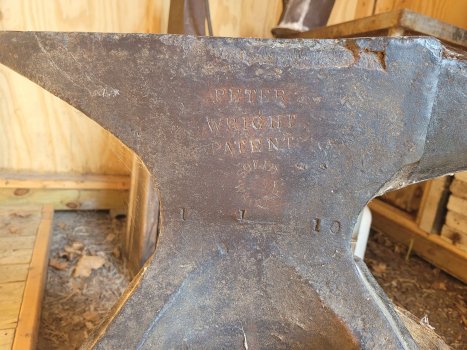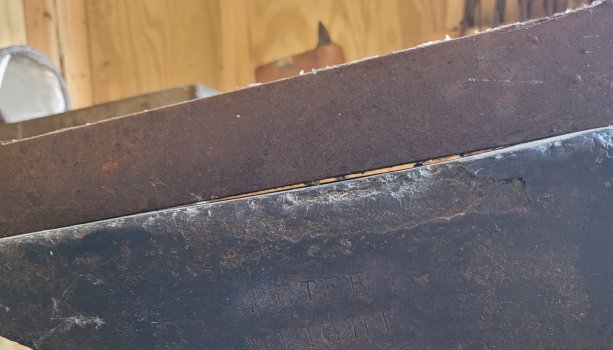You are using an out of date browser. It may not display this or other websites correctly.
You should upgrade or use an alternative browser.
You should upgrade or use an alternative browser.
Peter Wright anvil value?
- Thread starter Haines Custom
- Start date
Haines Custom
Well-Known Member
I'll have to check out the rebound and get more pictures.
Chris Railey
Well-Known Member
Like Billy said, pictures are needed of the face especially, from the side it looks like part of the hardened face has broken off. It may also have a sway but I cannot tell from the picture. PW's do tend to sway over time. I have one almost just like it.
Haines Custom
Well-Known Member
Chris Railey
Well-Known Member
What that is worth depends on who is looking at it. When I look at it, I see a well used anvil with some damage but it still has use in a forge. The edges, surface and table can be dressed and used as a teaching anvil, or when doing something like punching where I may damage my "good" anvil. The sway is bad for knife making but not too bad for general blacksmith work. With those eyes, I may give $200-275 to use it as a beater in my shop. The main reason is, I may hit that thing once and break it in half. It may last for decades in a shop but there is no way to tell which will occur so I prefer to spend $600 for a new anvil with a warranty.
All of that being said, I bet you, if you dress the edges, table and surface, someone will pay you $4 a pound for it.
All of that being said, I bet you, if you dress the edges, table and surface, someone will pay you $4 a pound for it.
Haines Custom
Well-Known Member
By dressing I assume you mean grinding it smooth?
CDHumiston
Well-Known Member
Here is a nice video...
Doug Lester
Well-Known Member
Definitely do not grind the face smooth. If you do you may grind away too much of the hardened face and destroy what rebound it has left. I would leave it as is.
Doug
Doug
billyO
Well-Known Member
Not sure I'd use the word "grinding", but yeah. I'd use a flap wheel (not a grinding disc) on an angle grinder just to soften the sharp corners. Like Doug said, you don't want to grind through the hardened face, so having a machined flat surface is not necessarily the goal here.By dressing I assume you mean grinding it smooth?
Haines Custom
Well-Known Member
Thanks everyone for the input.
fitzo
Well-Known Member
On a lot of Peter Wrights you can tell where the weld line is if you clean around the top inch of the sides of the anvil with a deburring or flap wheel. Those deburring wheels like an epoxy-coated very coarse scotchbrite stuff work great. That'll tell you if you have enough depth left to have it face-milled or surface ground flat.
Chris Railey
Well-Known Member
That is a good video. It's funny to me that we all marvel over the "ring" on an anvil when we first get it, then spend a lot of time and effort trying to stop it from ringing...
fitzo
Well-Known Member
Sorry if the vid mentioned this (I only watched the start). Ring magnet on the horn tip quiets 'em very nicely, better than a chain or nailing it down. Has to be on the tip for the best effect. (Trick learned from the lead smith at Centaur Forge, to give credit where due.)
If one is really handy with an arc welder, one can hardface an anvil and restore it, also. The anvil shown needs a lot of work, but one edge looks like it might be intact enough to re-radius and not have to do radical restoration stuff. That dip in the top is really problematic, though, without a secondary anvil-like-object to straighten on. It's also badly dinged up and that will reflect in the steel being hammered.
One other point about anvils: prices domestically for old anvils vary a great deal by region. A $4/lb anvil in one place is a $2/lb anvil somewhere else.
If one is really handy with an arc welder, one can hardface an anvil and restore it, also. The anvil shown needs a lot of work, but one edge looks like it might be intact enough to re-radius and not have to do radical restoration stuff. That dip in the top is really problematic, though, without a secondary anvil-like-object to straighten on. It's also badly dinged up and that will reflect in the steel being hammered.
One other point about anvils: prices domestically for old anvils vary a great deal by region. A $4/lb anvil in one place is a $2/lb anvil somewhere else.
Last edited:
Chris Railey
Well-Known Member
That is true. They are high in the south east for sure.One other point about anvils: prices domestically for old anvils vary a great deal by region. A $4/lb anvil in one place is a $2/lb anvil somewhere else.



